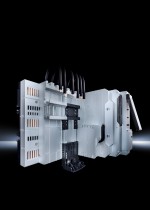Power management solutions
Published: 28 June, 2019
Matteo Todesco, senior marketing manager for Motive Power, EnerSys EMEA looks at the issues that adversely affect battery performance and how a power management system can mitigate these.
Modern warehouses typically rely on electric material handling vehicle fleets, with associated motive power batteries, chargers and battery handling devices that need maintaining. Keeping them in optimum condition makes sound financial sense. Firstly, well-maintained batteries and chargers last longer, are more reliable and allow direct cost-savings. Additionally, any shortfall in battery reliability impacts lift truck availability and an operation’s overall productivity.
While it’s an attractive concept, improved battery management often requires more information than most users possess. Even if individual lift truck data is available, understanding and acting on data from tens or hundreds of batteries is difficult. The challenge therefore, is to collect all battery and device data into a single, integrated platform.
While many warehouse operators believe that solutions either do not exist or are too expensive, an effective power management system is in fact available: one that gives electric vehicle users – from drivers to fleet managers - the insights they need to make productivity improvements and cost savings, without undue risk, installation costs or complexity during operation.
Battery and charger performance issues
Excessive operating temperatures can reduce battery operating life, or even cause failures. Insufficient water topping-up, poor equalisation and under-performing chargers can also cause problems. Insufficiently trained operators may under- or over-cycle batteries, leading to unequal utilisation.
Power management v Fleet management
The term ‘fleet management’, as widely used by materials handling vehicle OEMs, typically covers vehicle location, safe deployment and shock detection. Battery status reporting, if available, is not typically the main focus of these type of fleet management systems.
In this context, a better approach would focus entirely on energy and power management. And this becomes possible if the solution provider is sufficiently experienced in delivering energy and power storage devices and systems. One integrated solution combines innovative batteries and chargers with IoT wireless sensors and cloud-based software. The system provides actionable insights within easily-readable reports. The reports, accessible via PC, tablet or smartphone devices, are available to users anywhere, in real time. The data can also be delivered wirelessly to a dashboard-mounted display module in each vehicle, allowing drivers to see and respond to battery status issues in real time.
This approach gives users a much deeper understanding of their material handling vehicles’ battery performance. It also provides advice on how to successfully manage an entire battery fleet and optimise its performance.
What insights can a power management system provide?
Wireless battery monitoring devices, positioned on each vehicle battery, measure temperature, water level, discharge current, charge current, cell voltage imbalance and state of charge. This allows a cloud-based battery operations management system to alert supervisors to batteries with either actual or potential problems, or, crucially, to impending failures.
The system contributes to process improvement as well as highlighting individual battery problems. By revealing optimal battery charging times, double-cycling can be practically eliminated; batteries become more equally utilised. Optimal battery charging practices are highlighted, while the best charging room and opportunity charge points are identified. The system also recommends on fast and opportunity charging opportunities, and partial State of Charge (SoC) operation.
Battery wrong-sizing and low run time batteries can be identified, together with efficient intervals and water levels for flooded lead-acid battery topping-up.
Truck kWh energy used during truck operation and charging is revealed, allowing assessment of entire fleet overall energy use.
In conclusion, a power management system can help warehouse operators who are seeking to improve motive power battery efficiency. The system provides comprehensive coverage, from truck to cloud, and depths of insight into real-time battery status that were not previously available.
By highlighting problems related to both battery health and operator behaviour, battery runtime and longevity can be vastly improved. Additionally, the actionable insights provided by the management system fully support higher-level decisions and management processes. As a result, battery and charger fleets can be correctly sized, and budgeted for, based on actual usage.
For further information please visit: https://powermanagement.enersys.com/en/






 RITTAL, a leading global provider of solutions for industrial enclosures, power distribution, climate control, reports it is offering manufacturers of small control panels and switchgear an innovative and tested power distribution system. The company says the new RiLine Compact allows the user to mount different types of protective and switching devices onto a system, and then supply it with electrical power and says its standardised and standards-compliant technology means it is suitable for use in control panels in both the IEC and UL markets.
RITTAL, a leading global provider of solutions for industrial enclosures, power distribution, climate control, reports it is offering manufacturers of small control panels and switchgear an innovative and tested power distribution system. The company says the new RiLine Compact allows the user to mount different types of protective and switching devices onto a system, and then supply it with electrical power and says its standardised and standards-compliant technology means it is suitable for use in control panels in both the IEC and UL markets.
